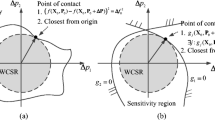Abstract
This paper presents the Regression-Based global Sensitivity Analysis method (RBSA). It is an approach for quantitative, variance-based, sensitivity analysis of mathematical models used for design purposes. The method is based on the subdivision of the global variance into its components, due to the design-factor contributions, using general polynomial regression models. The performance of the RBSA is compared to other methods commonly used in engineering for computing sensitivity, namely, the method of Sobol’, the Fourier amplitude sensitivity test, the method of Morris, and the standardized regression coefficients. It was found that RBSA, under certain circumstances, provides very accurate results with a significant reduction of the number of required model evaluations. A test case, using the mathematical models of two subsystems of a spacecraft, demonstrates how RBSA facilitates the discovery and understanding of the effects of the design choices on the performance of the system.
Similar content being viewed by others
References
Campolongo, F., Cariboni, J., Saltelli, A.: An effective screening design for sensitivity analysis of large models. Environ. Model Softw. 22 (10), 1509–1518 (2007)
Cardile, D., Ridolfi, G., Mooij, E., Chiesa, S., Ferrari, G.: A system of systems approach for the concurrent design of space missions. In: IAC-10.B5.2.3, 61st International Astronautical Congress. Prague, CZ (2010)
Cukier, R., Levine, H., Shuler, K.: Nonlinear sensitivity analysis of multiparameter model systems. J. Comput. Phys. 1 (26), 1–42 (1978)
Draper, N., Smith, H.: Applied Regression Analysis, 3rd edn. Wiley, New York (1998)
Helton, J.C., Davis, F.J.: Illustration of sampling-based methods for uncertainty and sensitivity analysis. Risk Anal. 22 (3), 591–622 (2002)
Iman, R., Conover, W.: A distribution-free approach to inducing rank correlation among input variables. Commun. Stat. Simul. Comput. 3 (B11), 311–334 (1982)
Kuri, A., Cornell, J.: Response Surfaces. Design and Analyses. Marcel Dekker Inc., New York (1996). 2nd edn. Revised and Expanded
Morris, M.: Factorial sampling plans for preliminary computational experiments. Technometrics 33 (2), 161–174 (1991)
Press, W., Teukolsky, S., Vetterling, W., Flannery, B.: Numerical Recipes. The Art of Scientific Computing, 3rd edn. Cambridge University Press, New York (2007)
Ridolfi, G., Mooij, E., Corpino, S.: A system engineering tool for the design of satellite subsystems. In: Proceedings of the AIAA Modelling and Simulation Technologies Conference, Chicago. AIAA 2009-6037 (2009)
Ridolfi, G., Mooij, E., Cardile, D., Corpino, S., Stesina, F.: Orthogonal-array based design methodology for complex, coupled space systems. In: IAC-10.B5.2.4, 61st International Astronautical Congress, Prague (2010)
Ridolfi, G., Mooij, E., Corpino, S.: A methodology for system-of-systems design in support of the engineering team. Acta Astronaut. (2011). doi:10.1016/j.actaastro.2011.11.016
Ridolfi, G., Mooij, E., Chiesa, S.: A modelling framework for the concurrent design of complex space systems. In: Proceedings of the AIAA MST Conference Proceedings, Toronto AIAA 2010-7782 (2010)
Ridolfi, G., Mooij, E., Chiesa, S.: A parametric approach to the concurrent design of complex systems. In: ESA Workshop - SECESA, Lausanne, CH (2010)
Ridolfi, G., Mooij, E., Corpino, S.: Complex-systems design methodology for se collaborative environment. In: Systems Engineering. Theory and Applications (2012). ISBN:979-953-307-410-7
Saltelli, A., Tarantola, S., Chan, K.: A quantitative model-independent method for global sensitivity analysis of model output. Technometrics 41 (1), 39–56 (1999)
Saltelli, A., Tarantola, S., Campolongo, F., Ratto, M.: Sensitivity Analysis in Practice. Wiley, Chichester (2004)
Saltelli, A., Ratto, M., Andres, T., Campolongo, F., Cariboni, J., Gatelli, D., Saisana, M., Tarantola, S.: Global Sensitivity Analysis. The Primer. Wiley, Chichester (2008)
Simlab: Software package for uncertainty and sensitivity analysis. Technical Report Last downloaded May 2010, Joint Research Centre of the European Commission (2010). Downloadable for free at: http://simlab.jrc.ec.europa.eu
Sobol’, I.: On the systematic search in a hypercube. SIAM J. Numer. Anal. 16 (5), 790–793 (1979)
Sobol’, I.M.: Sensitivity analysis for nonlinear mathematical models. Math. Model. Comput. Exp. 1, 407–414 (1993)
Wertz, J., Larson, W.: Space Mission Analysis and Design, 3rd edn. Springer, New York (1999)
Williams, C.K.: Prediction with Gaussian processes: from linear regression to linear prediction and beyond. In: Learning in Graphical Models, pp. 599–612. MIT Press, Cambridge (1998)
Author information
Authors and Affiliations
Corresponding author
Editor information
Editors and Affiliations
Appendix: Communication and Power Subsystem
Appendix: Communication and Power Subsystem
In Table 9 we describe the settings of the discrete variables used for the analysis of the communication and power subsystem. Further, the analysis of the communication and power subsystems cannot be performed considering them as separate from the other subsystems of the satellite and irrespectively of the orbit that the satellite will undergo. Some boundary conditions need to be set. In Table 10, the settings of all the parameters that significantly influence the performances of the communication and power subsystems are presented.
Rights and permissions
Copyright information
© 2016 Springer International Publishing Switzerland
About this chapter
Cite this chapter
Ridolfi, G., Mooij, E. (2016). Regression-Based Sensitivity Analysis and Robust Design. In: Fasano, G., Pintér, J.D. (eds) Space Engineering. Springer Optimization and Its Applications, vol 114. Springer, Cham. https://doi.org/10.1007/978-3-319-41508-6_12
Download citation
DOI: https://doi.org/10.1007/978-3-319-41508-6_12
Published:
Publisher Name: Springer, Cham
Print ISBN: 978-3-319-41506-2
Online ISBN: 978-3-319-41508-6
eBook Packages: Mathematics and StatisticsMathematics and Statistics (R0)




